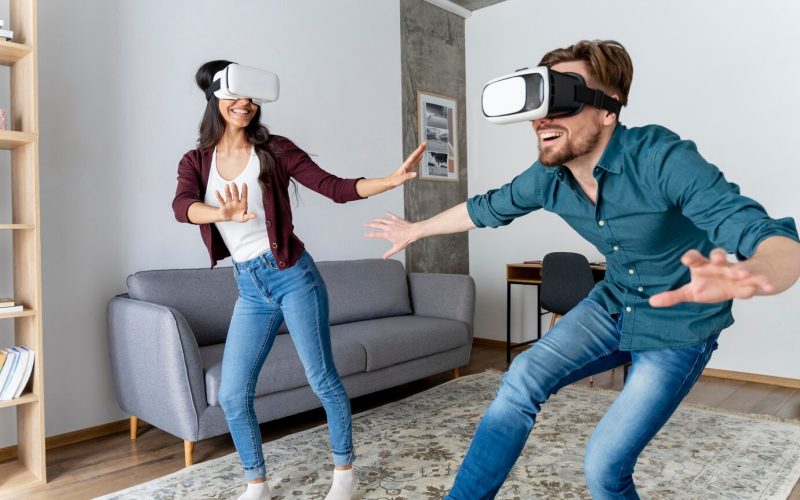Augmented Reality (AR) and Virtual Reality (VR) are no longer just buzzwords—they’re powerful tools that are reshaping the marketing landscape. As technology evolves, brands are increasingly turning to AR and VR to create immersive experiences that engage customers in ways that traditional marketing cannot. These technologies allow businesses to bridge the gap between the digital and physical worlds, offering unique opportunities to connect with audiences.
How AR Enhances Marketing Campaigns
Interactive Product Experiences
AR allows customers to interact with products in a virtual space before making a purchase. For example, a furniture company might use AR to let customers visualize how a couch would look in their living room. This interactive experience not only makes shopping more convenient but also increases customer confidence in their purchase decisions.
Engaging Brand Experiences
AR can be used to create engaging brand experiences that capture attention and generate buzz. Take, for example, a makeup brand that offers an AR app where users can virtually try on different shades of lipstick. This type of experience is not only fun but also encourages users to spend more time interacting with the brand, leading to increased brand loyalty.
The Impact of VR on Marketing Strategies
Immersive Storytelling
VR takes storytelling to a new level by immersing users in a fully virtual environment. Brands can use VR to create compelling narratives that allow customers to step inside the story. For instance, a travel company could offer a VR experience that lets potential customers explore a destination before booking a trip. This immersive storytelling approach can evoke strong emotional responses, making the brand more memorable.
Virtual Showrooms and Events
With VR, brands can create virtual showrooms or events that users can attend from anywhere in the world. This is particularly useful for industries like automotive or real estate, where seeing a product in person is traditionally important. A car manufacturer, for example, could use VR to host a virtual car launch, allowing attendees to explore the vehicle in detail from the comfort of their own homes.
AR and VR as Tools for Personalization
Tailored Shopping Experiences
Both AR and VR can be used to create personalized shopping experiences that cater to individual customer preferences. By integrating these technologies with customer data, brands can offer tailored recommendations and experiences. For example, a clothing retailer might use AR to suggest outfits based on a customer’s previous purchases and style preferences.
Data-Driven Insights
AR and VR also provide valuable data on how customers interact with products and experiences. Brands can analyze this data to gain insights into customer behavior and preferences, allowing for more targeted marketing efforts. This data-driven approach ensures that marketing campaigns are not only engaging but also effective in driving conversions.
Challenges and Considerations
Accessibility and Cost
While AR and VR offer exciting possibilities, they also come with challenges. One of the primary concerns is accessibility—both in terms of the technology required and the cost of development. Creating high-quality AR and VR experiences can be expensive, and not all consumers have access to the necessary devices. Brands need to consider these factors when planning their AR and VR marketing strategies.
User Experience
Another challenge is ensuring a seamless user experience. Poorly executed AR or VR experiences can lead to frustration and disengagement. Brands must prioritize user experience design, making sure that the technology enhances rather than detracts from the overall experience.
The Future of AR and VR in Marketing
Integration with AI
The future of AR and VR in marketing will likely see increased integration with AI. AI can enhance these technologies by providing real-time personalization and improving the interactivity of experiences. For example, an AI-powered VR shopping assistant could guide users through a virtual store, making personalized recommendations based on their preferences.
Expanding Reach
As AR and VR technology becomes more affordable and accessible, more brands will adopt these tools in their marketing campaigns. This will lead to a wider variety of AR and VR experiences, from interactive ads to fully immersive brand worlds. The key for brands will be to stay ahead of the curve, continually experimenting with these technologies to find new and innovative ways to engage customers.
Conclusion
AR and VR are poised to play a significant role in the future of marketing. These technologies offer brands the ability to create immersive, personalized experiences that stand out in an increasingly crowded digital landscape. While challenges remain, the potential rewards make AR and VR an exciting frontier for marketers willing to embrace innovation. As these technologies continue to evolve, they will undoubtedly become an integral part of successful marketing campaigns.






